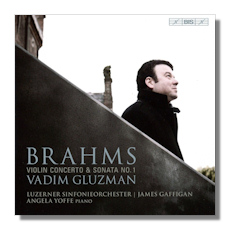
The Internet's Premier Classical Music Source
Related Links
- Brahms Reviews
- Latest Reviews
- More Reviews
-
By Composer
-
Collections
DVD & Blu-ray
Books
Concert Reviews
Articles/Interviews
Software
Audio
Search Amazon
Recommended Links
Site News
 CD Review
CD Review
Johannes Brahms

- Violin Concerto in D Major, Op. 77
- Sonata #1 for Violin & Piano in G Major, Op. 78
- Scherzo in C minor for Violin & Piano, WoO2
Vadim Gluzman, violin
Angela Yoffe, piano
Lucerne Symphony Orchestra/James Gaffigan
BIS SACD 2172 72:48
More than one critic or musicologist has classified Vadim Gluzman as a member of the Russian (or Russian-Jewish) school of violin playing, a tradition that boasts such stalwarts as Jascha Heifetz, David Oistrakh and Leonid Kogan. They are not incorrect in making that judgment of course, but the Ukrainian-born Israeli artist has a style that is nevertheless significantly different from that of these three iconic violinists from the past. For one thing, he generally employs more moderate tempos, though Oistrakh's pacing in the concerto was usually not much faster. In other works, like the Prokofiev sonatas, which I reviewed quite positively here in 2013 (BIS 2032), Gluzman (again with pianist Angela Yoffe) also tended to use moderate or even expansive tempos. In addition, Gluzman comes across, at least to me, as having a slightly more mellow tone and somewhat less aggressive style than the others.
Thus, these Brahms works are made to order for him. It's not that they are easy to play and lack bravura passages for the soloist, and it's not that Gluzman is short on virtuosity and vitality – indeed, he has plenty of technique and plenty of spirit in his interpretations – it's just that the two major works here are mostly mellow rather serene compositions, especially the sonata, and that Gluzman is better than most violinists in expressing such qualities. So, it's not surprising that this is a very lyrical, beautifully played Brahms Violin Concerto, abetted quite well by young American conductor James Gaffigan and his excellent Lucerne Symphony Orchestra.
I mentioned "vitality" in Gluzman's playing, and one illustrative instance of this is the violin's dramatic entrance in the concerto's first movement following the lengthy orchestral introduction: notice the sort of slashing thrust he gives to the notes, which adds even greater volatility to the sudden arousal in the music that began in the orchestra at 2:19. And take note also of how subtly Gluzman defuses the tension beginning at 3:02 as the notes slither downward and gradually bring on a sense of quiet and serenity. He phrases the beautiful Romantic theme beginning at 6:40 with a reasonably lively tempo, wisely eschewing the tendency to slow the pacing which can sabotage the music's flow as the underpinning by the pizzicato strings would loose its bounce and spirit. Gluzman plays the cadenza (the usual one in this concerto, by composer/violinist Joseph Joachim) with a real edge and sense of drama. A fine account of the first movement all around.
The second movement is beautifully played by both soloist and orchestra. It would be hard to imagine a better performance: here Gluzman takes a little bit of the sheen off his tone and imparts a greater sense of passion in the phrasing of the lovely main theme. He makes the violin sing – and almost cry. The finale has a rollicking, festive spirit, more so here than in most other recordings or performances, mainly because Gluzman adopts a slightly slower tempo than is usual and gives greater weight and emphasis to key notes in the theme. In fact, this is a quite muscular account of this movement, which, though it might shed some lightness, gives the music a more epic character and a more Brahmsian earthiness. A great performance of the concerto overall, one that can stand with the finest accounts on record.
The sonata is even more relaxed than the concerto, though it has a measure of darkness but not as a dominating factor. Did the violin bring out the more tranquil side of the composer? Maybe so, but the piano has half the notes here and it often drew out some of Brahms' more stormy creations. Whatever the source of calm was, Gluzman and Yoffe deliver a lovely and vital account, infusing the work with spirit and passion – and pointing up its somewhat melancholy elements: Brahms had written the sonata in honor of Clara Schumann's son Felix, a poet and violinist who died at the age of twenty-four from tuberculosis. Still, it's a mostly uplifting work whose wistful moments are outweighed by a gentle sunny character, especially at the close of the work. Gluzman and Yoffe effectively capture the lyrical and profound character of the music, never yielding to either exaggeration or diffidence. They strike a perfect chemistry, it seems, in their phrasing, technical execution and sonic balances. A gorgeous account of this great sonata.
The Scherzo is one work here that isn't relaxed in any way. It is a hearty, fiery piece that was part of a collaborative effort written for Joachim: Brahms, Schumann and Albert Dietrich contributed movements to a sonata for violin and piano in 1853. Brahms' contribution is a radiant, breathlessly paced six minute movement with a brilliant, triumphant ending. Again, Gluzman and Yoffe deliver an utterly splendid performance, the perfect piece to close out this recording, a sort of encore that stands in stark contrast to its siblings on this disc. BIS provides vivid, well balanced sonics in all works on this splendid SACD. Highly recommended!
Copyright © 2017, Robert Cummings


















